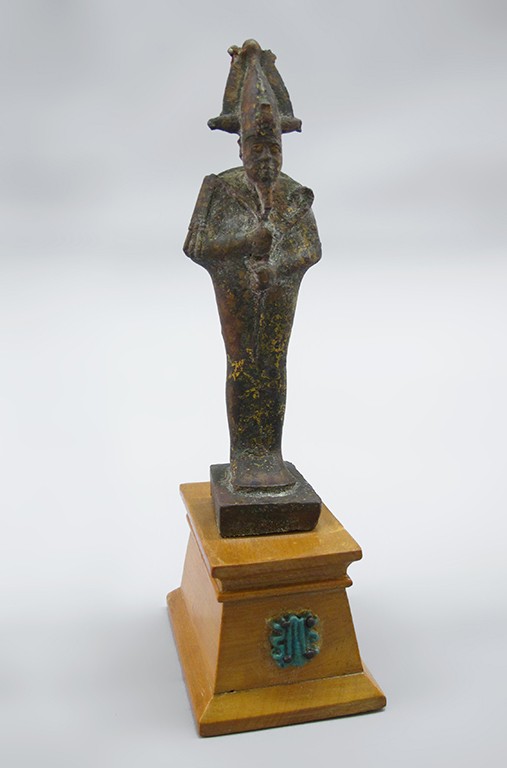2002 North Main Street
Santa Ana, California 92706
TEL: 714.567.3600
Mythology in Miniature: Statuettes from Ancient Egypt
 |
| Figure of an Ibis, 26th to 30th dynasty, (664-341 BCE) Egypt Bronze, gold leaf, and wood; 15 in. 2002.8.6 Gift of Mrs. Ramona Ward |
Downsizing
While ancient Egypt might be best known for its monumental architecture and sculptures—the Great Pyramids and Sphinx of Giza, Abu Simbel, Karnak—the vast majority of Egyptian sculpture was much smaller in scale. This post looks at a group of lost wax cast bronze Egyptian statuettes in the Bowers permanent collection dating as far back as 1000 BCE and explores both the use of these objects as well as the backstories of the mythological and zoological figures that they represent.
 |
|
| Figure of a Cat, 22nd to 30th dynasty (946-342 BCE) Egypt Bronze; 8 1/2 x 3 x 6 in. 80.60.3 Gift of Mr. & Mrs. Richard & Marilyn McCarthy |
Figure of Goddess Bastet, 22nd to 30th dynasty (946-342 BCE) Egypt Bronze and wood; 7 in. 80.60.4 Gift of Mr. and Mrs. Richard and Marilyn McCarthy |
Cats and Bastet
The above two figures, one of a cat and the other of Bastet, a deity associated with cats and who is often depicted as seen here with the head of a cat, are in many ways two halves of a whole. Cats were domesticated by Egyptians about 1500 BCE, perhaps due to their utility in controlling rodent populations. Soon they became regular household pets, and this newfound companionship is depicted in artworks from this period onward. Beginning in the earliest dynastic periods, Bastet’s popularity grew steadily from her home city of Bast on the eastern delta of the Nile River and temples and shrines for her spread throughout Egypt. There is an inscription from the time of Ramesses IV (1151-1145 BCE) that proclaimed that no lions could be hunted during the festival of Bastet, thus indicating the goddess’ divine protection of cats, both household pets and large wild animals. Bastet’s role in Egyptian society evolved over time; she became closely connected to the moon and the protection of an individual’s health and fertility. It was not uncommon for people from all walks of life to wear engraved amulets in the shape of Bastet. These amulets were thought to invoke her protection against mishaps and her assurance of their fertility.
These statuettes likely originate from around the same period after the popularization of Bastet. The one on the left depicts a cat that is elegantly poised with a slightly lifted head and a protruding chest on which a necklace pays homage to Bastet. The cat and the goddess Bastet were associated because of their shared protective and gentle traits especially linked to child birthing and rearing. Statuettes depicting cats and mummified cats were often offered at temples as symbols of devotion to the goddess; in some cases, mummified cats were sealed within the bronze statuettes. The statue of Bastet above on the right depicts the goddess holding a sistrum, or a type of rattle popular in ancient Egypt. A bronze statue like this was probably given to a temple of Bastet as an offering on behalf of the person who commissioned it.
 |
| Figure of Osiris, possibly 26th dynasty (664-525 BCE) Egypt Bronze; 5 1/8 x 1 5/8 in. 79.55.8 Gift of Mr. and Mrs. Richard and Marilyn McCarthy |
Osiris
Osiris was god of the Underworld, father of Horus, and the husband-brother of Isis. More even than this, he represents fertility, agriculture, life, death, and rebirth, as well as many of the unifying forces of the universe in ancient Egyptian religion and cosmogony. His myth holds that he was killed by his brother Set and carved into pieces. When his body was reassembled by Isis, he returned to life. The earliest evidence of his worship dates as far back as 2500 BCE and remained consistent all the way through to the introduction of monotheistic religions to the region. Here Osiris is depicted in typical fashion holding a crook and flail, icons borrowed from an even earlier deity, Andjety.
Ibises
The excellent artistic rendition of a standing ibis that serves as the banner image for this post captures the elegance of the long-legged, curved-billed wading bird. The ibis is associated with the Egyptian god Thoth, the scribe of the gods, measurer of time and inventor of numbers. In the judgment hall of Osiris, Thoth records the results of the weighing of hearts which determines the deceased’s entry or refusal into eternal life. Despite not worshiping animals, Egyptians commonly attributed animal traits to gods and then used those creatures for ritual purposes. Egyptian archaeological sites have cumulatively revealed over a million mummified ibises, some of which have been found with decorative wrappings. Mummified and less often sealed in bronze statuettes were offerings to Bastet. Studies of the animals' remains suggest that they may have been bred as offerings since many were found to be young in age.
 |
| Figure of Ptah, Saite period (c. 800 BCE) Egypt Bronze and wood; 1 1/2 x 6 1/8 in. 2003.62.1 Gift of Mrs. Ramona Ward |
Ptah
This bronze statuette of Ptah dates to the Saite period (800 BCE). A superb example of a standing slender figure of the god of life and patron of Memphis, he is depicted here wearing a tight-fitting cap, hands emerging from close-fitting cloak holding a was, a scepter that served as a divine symbol of power, stability, and dominion, terminating in a jackal's head. The incised facial features, striated beard, patterning of his collar and cloak, all show the high degree of detail that went into the lost wax casting of these figures.
Text and images may be under copyright. Please contact Collection Department for permission to use. Information subject to change upon further research.

Comments